Broccoli Seed Production: Quick Reference - Organic Seed Alliance
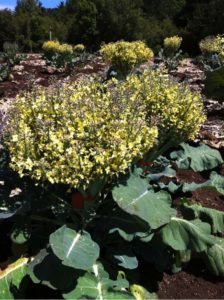
Broccoli Seed Production
Broccoli is both an annual and biennial crop depending on whether you are producing seed of a sprouting or heading type of broccoli. Sprouting broccoli will require vernalization (6-8 weeks of cold accumulation) before flowering and seed production will occur.
| Broccoli growth habits | |
| Beinnial | Sprouting types |
| Annual | Heading types |
Production
Broccoli likes moderate temperatures between 60-75°F. When temperatures exceed 90°F for extended periods, pollination and early seed set can be negatively affected. Broccoli also likes early season moisture, which encourages rapid growth. Climates with mild springs, relatively mild summers, and dry fall conditions are ideal for broccoli seed production. Once heading begins, too much moisture can encourage head rot and disease. Seed development is best when conditions are dry. Broccoli likes well balanced soils and has a high demand for boron and molybdenum (Mb). Deficiencies in molybdenum can cause whiptail. To make molybdenum more available in your soils, ensure a low pH of 5.5. Otherwise, pH between 6.0 and 6.6 is optimal. Broccoli is insect-pollinated and self-incompatible, which ensures outcrossing unless hand pollination is used before the flowers open (bud pollinating). Many insects are effective pollinators.
Annual heading broccoli varieties are weak biennials and vernalization needs are generally met by cool nighttime temperatures. These types are planted in the spring for late summer or early fall seed harvest. Biennial sprouting broccoli varieties require full vernalization and must either be overwintered in the field or kept in cold storage for at least 8 weeks. These types are usually transplanted in mid- to late summer to ensure two-thirds of growth is attained before the onset of winter. For both types, seed should be started in a greenhouse (more common for colder climates, such as the Intermountain West) or nursery bed and transplanted after 4-6 weeks, ensuring that seedlings do not experience temperatures lower than 50°F for extended periods. Cold temperatures cause “buttoning” or premature bolting. Plants should be spaced 18-24 inches apart in rows that are 2-3 feet apart. Broccoli flowers should be fully formed before the onset of summer heat when aphids begin to be a problem and pollination can be reduced by high temperatures. In fields where wind is a problem, staking will be necessary once plants achieve full seed production maturity size. Even without consistently windy conditions, staking may be necessary since the plants often can’t support the weight of the flowering shoots and developing siliques.
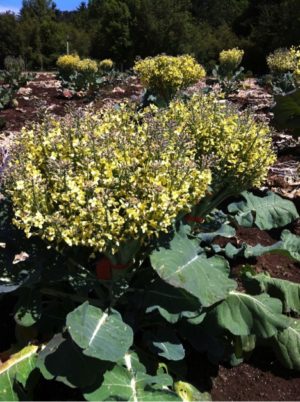
Broccoli will flower over an extended period of time. Thus, seed will also mature over a period of time. When the seed pods (silques) turn light tan or buff colored, the plants are ready to harvest. When 60-70% of the silques are ready, cut the plant at ground level, windrow, and dry for another 1-2 weeks in the field or in a well ventilated hoophouse or greenhouse.
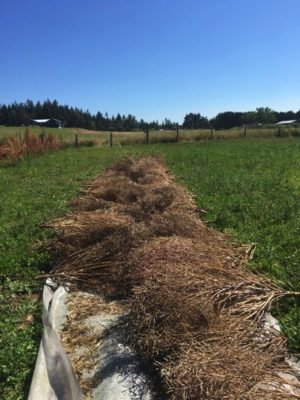
When seeds are mature and adequately dry, the silques will break open easily to release the seed. For small amounts of seed, thresh by hand – rub between your hands, bang the plants with a threshing stick, walk on the plants on grass or another soft surface, or bang plants on the inside of a container or tote. For larger amounts of seed, run over windrows with a truck or tractor as long as the windrow is on a soft surface such as grass. Do not thresh on a hard surface such as gravel or concrete as seed may crack or get smashed. Once threshed, winnow, scalp with a pitchfork, or rough screen with a large gauge screen to remove the majority of the chaff.
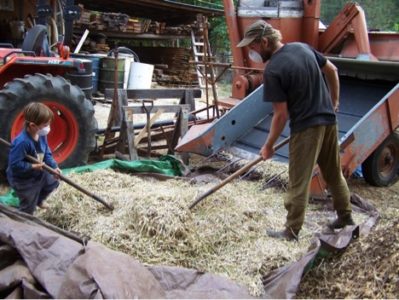
Use a combination of winnowing and screening to clean the remaining seed. Use hardware cloth or precision cut round-holed metal screens with diameters smaller than the seed to remove fine debris. Final processing may require an air separator or spiral separator.
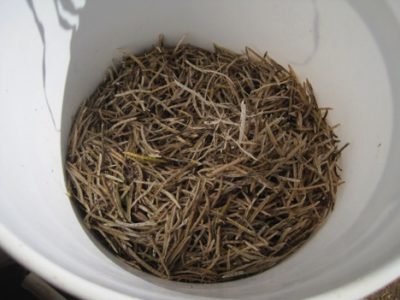
Selection and Variety Improvement
Grow between 50-90 plants to retain population vigor. Because open-pollinated varieties are often variable, plant at least 130 plants to allow for continual selection and roguing. For sprouting types, eliminate plants that flower before winter (and full vernalization) and select for cold hardiness after overwintering. For heading types, domed heads with tight beads are best as they shed water, which helps to prevent disease.
| Trait | Timing |
| Seedling vigor/damping-off resistance | 1-2 weeks after emergence |
| Leaf type | Head harvest |
| Leaf color | Head harvest |
| Plant stature | Head harvest |
| Plant vigor | Month after transplanting; head harvest |
| Disease presence | Before heading (25-40 days after transplant); head harvest |
| Insect pest pressure | Before heading (25-40 days after transplant); head harvest |
| Head size | Head harvest |
| Head shape | Head harvest |
| Head color | Head harvest |
| Bead size | Head harvest |
| Time of head harvest | Head harvest |
| Harvest window | At each head harvest |
| Side shoot production | At each head harvest |
| Flavor, texture, eating quality | After head harvest |
Disease
Use disease-free seed and a 3-5 year crop rotation (5 for diseases like Black leg). Eliminate wild crucifer weeds that may host diseases. Avoid overhead irrigation and water only in the morning. Increase plant spacing and orient rows toward prevailing winds to minimize disease. Incorporate residues into the soil to prevent overwintering diseases. Some states regulate Black leg, so if selling out of state, you may be required to test for the presence of this disease. Diseases are classified by severity with a class of 1 being the most severe and 3 the least severe.
| Disease | Type | Severity class | Favorable conditions | Control measures |
| Black rot (Xanthomonas campestris pv. campestris) | Seedborne | 1 | Warm and humid following a period of rain during early development | Hot water (25 min. at 122°F) |
| Xanthomonas leaf spot (Xanthomonas campestris pv. amoraciae) | Seedborne | 1 | Prolonged periods of dew or rain over a wide range of temperatures | |
| Xanthomonas leaf spot (Xanthomonas campestris pv. raphani) | Seedborne | 1 | Prolonged periods of dew or rain over a wide range of temperatures | |
| Black leg (Phoma lingam) | Seedborne | 1 | Rainy, cool weather | Hot water (25 min. at 122°F) |
| Black spot (Alternaria brassicicola) | Seedborne | 1 | Moderate temperatures (60-80F) and high humidity | |
| Alternaria diseases (Alternaria brassicae) | Seedborne | 1 | Moderate temperatures (60-80F) and high humidity | Hot water (25 min. at 122°F) |
| Downy mildew (Peronospora parasitica) | Seedborne | 3 | Cool (45-60F) and moist | |
| Fusarium wilt (Fusarium oxysporum f. sp. Conglutinans) | Seedborne | 3 | Hot (80-90F) and humid | |
| Peppery leaf spot (Pseudomonas syringae pv. maculilola) | Seedborne | 3 | Cool and rainy | |
| Verticillium wilt (Verticillium dahliae) | Seedborne | 3 | Cool and moist | |
| White rust/White blister (Albugo candida) | Seedborne | 2 | Cool and wet | |
| Clubroot (Plasmodiophora brassicae Wor.) | Root | |||
| Root knot (nematodes) | Root | |||
| Bacterial head rot (Pseudomonas spp. Pectobacterium carotovorum) | Foliar | |||
| Alternaria head rot (Alternaria spp.) | Foliar | |||
| Cabbage worms | Insect | |||
| Aphids | Insect | |||
| Flea beetles | Insect | |||
| Whiptail | Mb deficiency |
This resource was made possible thanks to the Montana Department of Agriculture’s Specialty Crop Block Grant Program.

